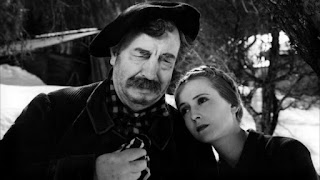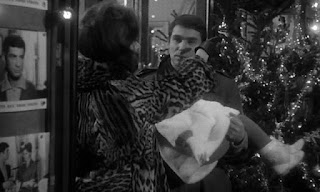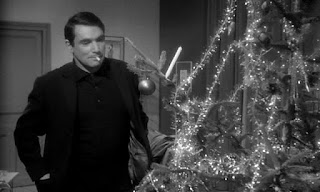In Italy, December 13 is the day St. Lucia is celebrated who was murdered in 304 AD for refusing to be married. Her death on the Julian calendar was closer to the Winter Solstice on the darkest day of the year, but the Nordic countries kept the date when the Gregorian calendar was later adopted and solstice fell on the 20th of December. Lucia has long been celebrated in Sweden with a tradition of selecting a woman with candles in her hair to lead a procession of maidens, star boys and gingerbread children who bring forth the light.
In San Francisco, a French noir Yuletide double feature is being shown at the Roxie Theatre on December 13– L’ASSASSINAT DU PÈRE NOEL (Who Killed Santa Claus - 1941) by Christian-Jaque and LE MONTE-CHARGE by Marcel Bluwal (1962). Both films could hardly be claimed to be light entertainment and as crime fiction are associated with noir. The films do not evoke warm fuzzy feelings for Christmas but are dark and brooding plots involving intrigue, deception and murder. There are children in these films and Santa Claus but little joy for the them or the adults that try to make the best of the holiday.
L’ASSASSINAT DU PÈRE NOEL (Who Killed Santa Claus - 1941) has none of the stylistic of noir in terms of lighting. Most of the dark heavy gothic scenes without light are filmed indoors or are shot in the super bright snow on sunny days in the French Alps. The setting is a village near Grenoble where the town pharmacist Ricomet (Jean Brochard) goes to order medicine for the village, one of the many threads of the plot.
Gaspard Cornusse dons his Father Christmas costume every year for the children played by Henry Baur, a rotund, jovial character with heavy drawn eyebrows in his early 60s. Gaspard makes toys such as world globes that light up. His acting style is steeped in a classical theatrical tradition. At times Gaspard's makeup seems like he will peel it off and another person will emerge. In the corner of his living room is a shrunken head of an Asian man, and as it is hanging he tells the village children the story of the bandit Fu-Xiyu who robbed for his daughter Princess Aurora.
 |
|
Henry Baur and René Faure |
Meanwhile upstairs his daughter Catherine (Renée Faure) lives in a world of fantasy, raised on her father’s stories waiting for a romantic hero to carry her off on a white horse. Elsewhere in the film is a poor woman referred to as Mother Michel (Marie-Hélène Dasté) who searches the village looking for her cat and was formerly married to Ricomet. Both of these female characters are not noir femme fatales but evocative women who are deeply disturbed because of the influence of the men in their life. Women serve the men of the village who wear large black berets and spend time drinking or gambling. True to fairy tales, Catherine falls for a man she believes to be a prince with hand covered by a black glove he claims has been deformed by leprosy, Baron Roland de la Faille (Raymond Rouleau). She is being courted by an annoying village teacher who threatens to punish wayward students by having them write about their grievances over and over. After meeting the Baron Catherine only has eyes for him.
The film includes a Tiny Tim character, a young boy, who lies sickly in bed waiting for the gift he ordered from Santa Claus. There is also a thief in town who has taken St Nicolas’ ring from the village church and Santa Claus is found shot in the head in the Alps. Getting to the bottom of the mysteries in play involves calling in the territorial police and the townspeople and officials.
Director Jaque brings out staid acting performances which border on overacting –children and adults alike, following the fiddle of Henry Baur, Father Christmas. During the time the film was made, France was under German occupation and the film was produced by the Nazi film company Continental Film. Director Christian- Jaque and screenwriter Charles Spaak were able to create a subtext to the film with subversive themes with allegories to the political realities. In real life Baur’s wife who was Jewish was taken away by the Gestapo and he was tortured and arrested the year after the film was made. After being released from prison he died in mysterious circumstances.
LE MONTE-CHARGE by Marcel Bluwal (1962) starring Robert Hossein and Lea Massari has a noir stylistic with trains emitting billowy white smoke as they charge up a dark railway. It is set in a seedy looking Paris suburb - Courbevoie with notable signs pointing to and from Argenteuil on the other side of the Seine. Films featuring Hossein are often populated by districts of Paris, fictitious or real. On Christmas Eve, Robert Herbin (Hossein) has just gotten out of prison after seven years for murdering his boss’s wife. On his first night out, he takes notice of Marthe and her little daughter Nicole (Pascale Brouillard ) in a restaurant. Nearby is a movie theater and Robert follows Marthe and Nicole inside. During the screening Marthe allows him to put his hand on her shoulder and later to follow her home and come in for a drink. The apartment is big and spacious on top of her husband’s factory, nicely furnished with a sparsely decorated Christmas tree. In a series of attempts at passion followed by rejection, Marthe has the upper hand of Robert. She leaves with him to go to his apartment leaving Nicole alone, and then changes her mind and returns to her apartment again only to discover her husband dead. Robert must leave because he can’t be found anywhere near Courbevoie but is obsessed with Marthe. He follows her to Midnight mass where she faints, and then takes her home again assisted by another man who sells American cars.
 |
|
Lea Massari, Pascale Brouillard and Robert Hossein |
Christmas eve is robustly celebrated with last minute Christmas shopping, family get togethers in restaurants, fights in bars and a packed church of worshippers.
Le Monte is a somber thriller involving murder, deception and a little girl dressed in a white fur parka whose step father hates her. Marthe’s attempt to leave a loveless marriage is well-planned where she uses men to help free her from her entrapment. Everything about the set design conveys this feeling of confinement from dark, shabby apartment houses to desolate streets of loneliness. Robert and Marthe cling to each other to free themselves from their circumstances yet wind up creating a complicated relationship that frightens them both.
 |
|
Robert Hossein |
© 2017 - Moira Sullivan- Air Date: 12/13/17
Movie Magazine International
Republished with permission























 Moira Sullivan
Moira Sullivan 


